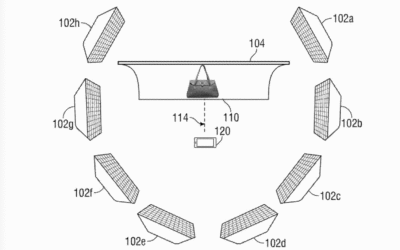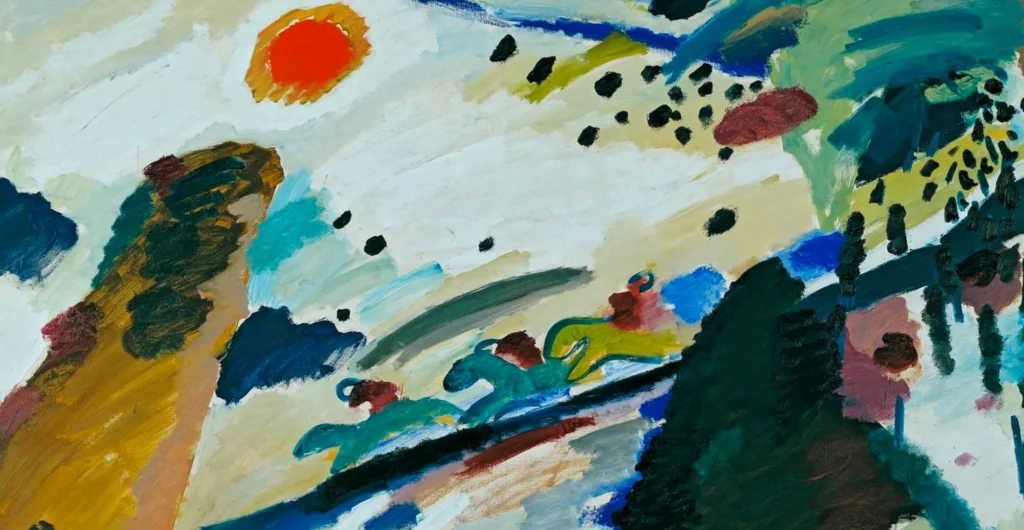The Art of Digitization: Mantua’s Apollo meets QuantumSpace Data Analysis
Called upon by Palazzo Ducale’s curator, we applied our patented algorithmic approach to the analysis of one of the most important artworks in the collection of the Gallery: Mantua’s Apollo. By the leverages of high-resolution photography and supervised artificial intelligence, we demonstrate a non-invasive method for digital restoration and condition assessment of classical sculptures.
Our technology is not limited to detailed 3D reconstruction, but also provides a scientific identification of previous restorations, and adds a visualization of possible missing elements – all done without physical contact with the artwork itself.
This methodology offers advantages in preservation, cost-effectiveness, and scalability while building a comprehensive heritage database for comparative analysis, thus granting a technological advancement and combining scientific precision with accessibility for museums and collections worldwide.
Apollo, Mantua, 2024
Exposed to the public in Palazzo Ducale, the object of the analysis that we present to you — the Apollo of Mantua — is a prestigious Roman statue, sculpted in pristine Greek marble and dating from the second century AD, more specifically between Hadrian’s ruling years and the early period of the Antonine dynasty.
A work of refined taste, its proportions are classic and its features sophisticated. The subject has a juvenile appearance, a slender body, and a delicate face: it’s a boyish Apollo, whose back muscles are mildly defined, especially on the shoulder blades and along the spine. The pose follows the rules of the classical chiasmus: the right shoulder, raised, is placed slightly forward of the left, more relaxed, while the left leg, stiff, is positioned behind the right one, leaning softly forward.
This studied composition gives us a harmonic, clear, and elegant image.
This statue is a marble copy of a bronze Greek one, following a typical Imperial Rome practice of that historical period called Imitatio. Little do we know about the original artwork it was copied from, except for a possible attribution to Phidias which has never actually been confirmed by definite proof. Despite its unknown origins, the Apollo is named after the Lombard city of Mantua, where it was found, and it stands as the first discovered example of a theme fairly popular at the time: that of Apollo Citarista, which refers to the representations of the music God, in various stances, accompanied by his zither.
In this specific case, Apollo is leaning on a laurel log, the plant sacred to the God, which covers almost all of the left side of his face: around this log, a snake is wrapped tightly, looking at a bird of unknown species sitting on the top of it.
The compositional structure might suggest to us a hint of the species to which the two animals belong, given that the bird and the snake exchange a hate-filled look: the latter could be a hawk, Apollo’s messenger animal, while the former might have been thought of as a reference to Python, the mythological monster defeated by the God.
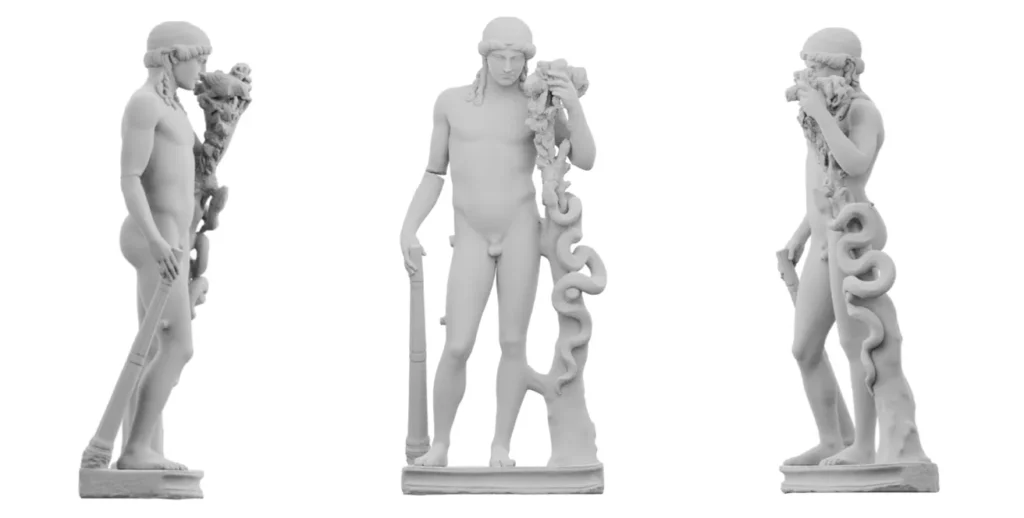 Unknown Artist – Mantua’s Apollo – Artwork’s Digitization
Unknown Artist – Mantua’s Apollo – Artwork’s Digitization
Marked by Time
Altogether, the main body is in an excellent state of preservation, except for some scratches on the nose and some chipping on the toes. Unfortunately, the same can’t be said for other elements of the sculpture: not only is the right arm missing, but it’s quite clear that at least another compositional element has been lost, as deducible from the chopped-off props on the hip and leg. Hence, the original right hand was most probably holding the string of a quiver, with its bottom resting on the base where we can still see its severed end.
Over the years, many theories on the lost arm have been made, and during our analysis processes, in the same collection in Palazzo Ducale, we have been shown a right arm holding a torch, which was probably meant to replace the missing part. The element at stake, however, does not fit the original supports and, as we can see from the reconstructions that we will discuss later, it strongly alters the original composition.
The integration of this element to the main body, with its connection, was never carried out. We are not sure of the reason why, as this restoration was never carried out either because of the high risk of damaging the statue or in order not to further change the original composition.
The missing right arm is only one of the elements telling us how the statue we see today is surely not in the same condition as when it was sculpted: as the figure before us is the result of a series of more or less mindful renovations, it appears clear that a technical and scientific analysis is more than required.
As an example of the various restoration processes that the sculpture went through, we can observe the piece of laurel between the snake’s head and the hawk’s point of connection to the log, which is made of chalk instead of marble, as a preposterous filler for a missing part.
An interesting case study could be an evident crack on the left wrist: the extremely detailed hand and the final piece of laurel are a single piece of marble, connected to the rest of the sculpture by elements in chalk added later, and positioned in a stance that emphasizes the crack itself.
This suggests two different hypotheses: the first theory is that the hand was an original part of the composition, reassembled without the necessary attention with an installation made of chalk, like the serpent’s head; the second theory, on the contrary, leads us to think that it was chosen from a similar hand from another sculpture and that it was placed later on this statue. Both these theories are plausible but difficult to study.
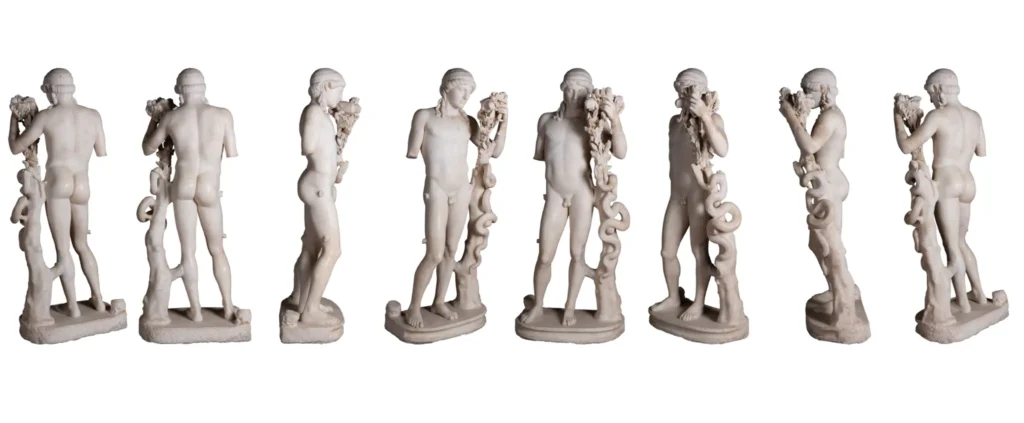 Unknown Artist – Mantua’s Apollo – Artwork’s 360 Degrees Digitization
Unknown Artist – Mantua’s Apollo – Artwork’s 360 Degrees Digitization
Breaking Point
And here we are at a critical point: if an exact copy of the sculpture existed, we would have the basis for a plausible reconstruction. But even a close enough replica could set a realistic base for a proper restoration.
As we anticipated, the statue belongs to an iconographic theme and, although many copies have been lost, some have survived: compositionally and stylistically speaking, the closest to the Mantuan Apollo is the Apollo from the House of the Citharist in Pompeii. Altogether, the sculptures are very similar, but some details are different: the left arm is bent, probably to hold an object never identified, and in the right hand we see a pick, while the head is slightly turned to the left.
Based on this simple analysis, referring only to the existing sculptures might be insufficient for the reconstruction of our case study.
In cases like this, mathematical analysis and artificial intelligence become innovative elements in the field of renovation and preservation of existing heritage, with a series of affordable and effective processes.
All that is needed are high-resolution photographs capturing all sides and details, especially the critical points to restore, like the scratches on the face and toes or the deep cracks that we analyzed before.
All of this is achievable without complex instruments or a highly prepared team, for the necessary results are achievable through the work of a single photographer with average quality equipment and the right training: the process guarantees quality more than comparable to traditional tools with a fraction of the cost.
With the photographs taken, a digital process is set in motion to both analyze and digitally restore the item.
The final achievement is a highly detailed 3D digital version of the sculpture, followed by a full-scale analysis and the storage of all the obtained data in our database.
Artificial Intelligence
This is the job done by QuantumSpace with the Apollo: offering pro bono its services to the Greek-Roman Mantua Museum, it demonstrated the great potential of the methodical analysis and application of artificial intelligence in this field. The photographs taken, as stated, are just the first stage of an automated process: they are then elaborated by software that evaluates the work in its entirety and shows us step by step the modifications and additions made.
This process happens without touching the statue, removing the risk of damage by physical iterations. This, indeed, is the biggest challenge in a restoration, especially regarding the most compromised elements.
As a proper case study, the software successfully elaborated the missing arm and, most of all, gave an element of analysis regarding its position through a three-dimensional prototype.
Then it proceeded with a complete reconstruction of the hypothetical elbow joint, processed a lot faster than a physical restoration and, most importantly, in a reversible manner.
Artificial intelligence applied to high-resolution photographs has also a further benefit compared to classical scanning with three-dimensional detectors or 3D scanners: it can elaborate a larger amount of data in a reduced timeframe, thus allowing our team to digitalize entire collections in an optimized fraction of time.
Perhaps even more important is the safety that this process guarantees compared to a physical restoration, considering that the statue is never under the risk of being damaged and the results given are also reversible.
Another feature of our software is the ability to store all the data we previously referred to.
During the digitalization of the statue itself, from the texture and analysis of the materials to the detailed conservation of the pattern of the cracks, every meaningful piece of data is stored and preserved in databases made to last.
This process guarantees the preservation of works of art on a level of detail and authenticity more than satisfactory for current standards, providing the opportunity to store and analyze artistic and museological heritage with the application of scientific methods.
This opportunity is not to be underestimated as many artworks have been lost or damaged through time or by human negligence, but also because of circumstances beyond our control and hardly fixable.
QuantumSpace aims to be an available solution, one that guarantees an optimized way to achieve the fundamental result: the conservation of existing cultural heritage through a complete, methodical, and precise process.
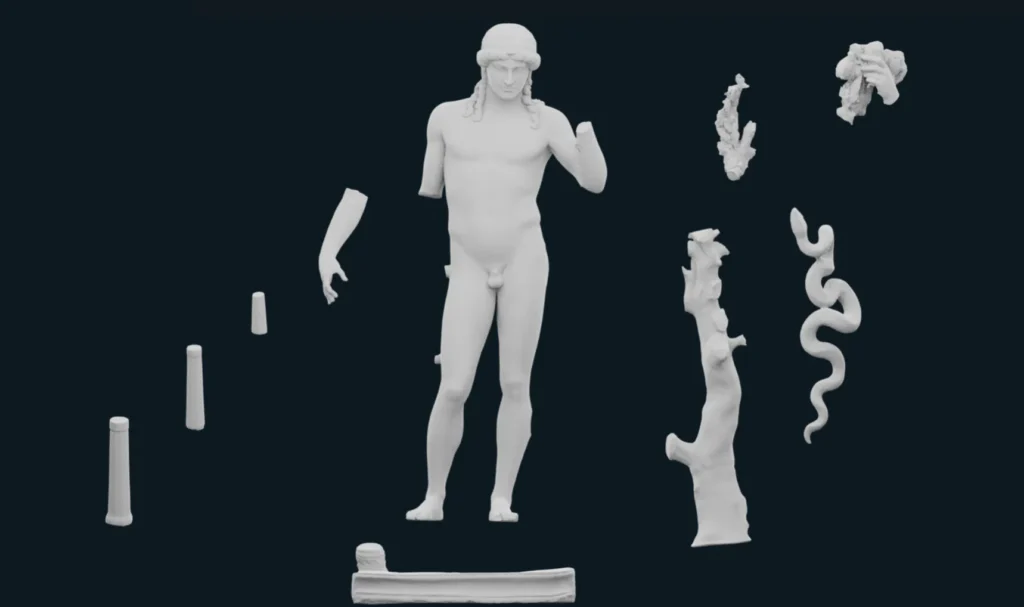 Unknown Artist – Mantua’s Apollo – 3D Reconstruction
Unknown Artist – Mantua’s Apollo – 3D Reconstruction
Conclusion: Towards a Scalable Future
As stated in the previous evaluation, the most important advantage behind this technology is the scalability of the procedure, as we offer a process where requirements are limited compared to the achievable results.
Furthermore, every digitalized artwork increases our heritage database and, in addition to guaranteeing preservation, makes it possible to analyze and compare more artworks day by day, facilitating at the same time the job of those who work with pieces of art or collections difficult to handle. Not only do we guarantee quality and precision, it is also our job to grant a scientific and technical approach to both preservation and restoration.
The analysis we process brings us to achieve better and better results, with an increasing number of high-quality information, and to constantly consolidate our knowledge about more or less well-known artworks.
As if this process alone were not enough, we also offer complete digital restoration.
We are confident our work represents a step in the right direction for the future of art and its preservation, and we are eager to prove the quality of the outcome while constantly pushing past the limits that are presented to us.

